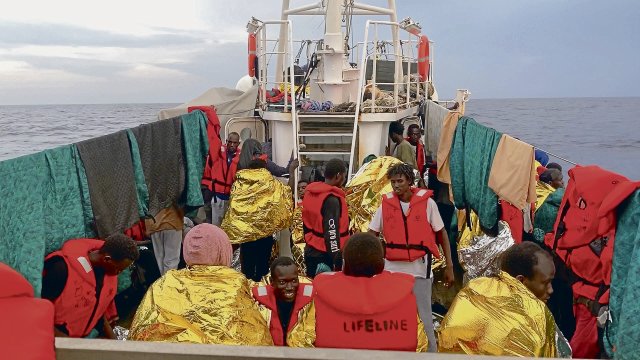Rescued. Joy, but also thoughtfulness, uncertainty.
Photo: UCM.One
Dying in the Mediterranean has become commonplace. The boundaries of perception have shifted – with the active support of politicians – and if the refugees even make it into the news, it must be a real drama. Things were different a few years ago, when a majority of society paid their respect to the actions of sea rescuers and they were recognized for their moral courage. As Fortress Europe continues to expand, organizations like Seawatch and Mission Lifeline have found themselves on the defensive. Not only is their work increasingly hindered and prosecuted, the tide in public discourse has also changed. This can be clearly seen in the program of the new party BSW, which, despite its supposedly progressive orientation, uses the well-known “the boat is full” narrative and wants to fight migration. At least, unlike most other parties, it still addresses the causes.
nd.DieWoche – our weekly newsletter

With our weekly newsletter nd.DieWoche look at the most important topics of the week and read them Highlights our Saturday edition on Friday. Get your free subscription here.
People who don’t regularly follow left-leaning media may not even know that civilian sea rescuers are still sailing the Mediterranean. This makes the documentary “One Hundred Four” by the young Leipzig director and cameraman Jonathan Schörnig all the more important, even urgent, and was honored with four prizes at the Leipzig Dokfilmfest in 2023, including the main prize, the “Golden Dove” for the best feature-length film. In addition to the fact that the ongoing scandalous situation of those fleeing across the Mediterranean is once again being discussed, “One Hundred Four” fills a blank space, because exactly how a sea rescue actually works is largely beyond our knowledge. At best, we know of images or news clips that present the event in a broadcast-friendly format in 1:40 minutes. “One Hundred Four,” on the other hand, is a real-time documentary that shows how painfully long it takes and how complicated it is to save 104 people (hence the film title) from a sinking rubber dinghy.
The “plot” begins when the “Eleonore”, the ship of the Lifeline mission, sights a floating object some distance away at sea and sends its dinghy there to find out whether it is refugees. The suspicion is confirmed when the boat approaches a vehicle that was once an inflatable boat, but is losing air and is struggling to stay afloat with the side walls already slack. The first task of the rescue crew is to bring calm to the scene in order to prevent panic and the certain destruction of the vehicle.
The drama of the situation meets the pleasant professionalism of the sea rescuers, who coordinate the rescue of the shipwrecked people with a practiced routine and always paying attention to their own safety and first ensure that everyone receives a life jacket. Meanwhile, the reception and initial care of the 104 people – all young men – is being prepared on the mother ship. The viewer is closely involved in all of this. Several cameras running in parallel film the event from different perspectives – the screen is divided into up to six individual segments. There is no film montage in the classic sense and is replaced by switching between different camera positions and locations. This breaks conventional viewing habits and sometimes makes it exhausting to follow all the details. But “One Hundred Four” doesn’t want to be a conventional documentary and it’s certainly not concerned with beautiful images. The cameras, some of which are permanently mounted and static, give the impression of surveillance cameras. The drama comes solely from the authenticity of what is happening in real time.
The film accompanies the campaign person by person, step by step. The situation comes to a head when the Libyan Coast Guard shows up and tries to hinder the rescue operation. Their ship repeatedly comes dangerously close to the refugees on the dinghy and spreads fear and terror. The meaning of this aggressive behavior is not entirely clear, especially since those involved are in international waters. But if you know that the Libyans are acting on European orders and are being paid to pick up and repatriate refugees, the angry threatening gestures in the face of the “defeat” – they can no longer really prevent the rescue operation – are understandable. The rescued people and the crew then have to wait for days on the high seas because no European Mediterranean country allows them to dock. Only after a bad storm does a port necessarily allow them entry.
What sounds like a bad adventure film is a bitter reality for those fleeing to Europe. Worse still: every year the most dangerous escape route in the world claims thousands of lives, but hardly anyone seems to care anymore. In addition to the habituation, or rather dulling, effect, the focus of attention has simply shifted, first towards Ukraine and most recently towards the Middle East. It is also an open secret that the EU border protection agency Frontex, instead of helping shipwrecked people, carries out illegal pushbacks and massively hinders sea rescue missions such as Mission Lifeline, but this blatant violation of applicable law is also tacitly accepted by European governments. So much for values-based foreign policy.
The successful European isolation policy is also reflected in the increasingly rare media reporting. Since the EU has obliged Mediterranean countries such as Libya, Egypt and Turkey – all more or less authoritarian regimes – in exchange for a lot of money to stop the flow of refugees if possible, the misery has been taking place where no one is looking and the press has been easier to keep in check than in Europe. The fact that this documentary exists is not a contradiction, because the material comes from 2019, when private sea rescuers were still able to work comparatively unhindered. Such recordings would now be difficult to make and rescue missions are consistently criminalized.
In that same year, 2019, charges were also brought against the captain of the “Eleonore” because, at the end of the rescue trip and with 104 refugees on the completely overcrowded ship, he entered an Italian port without permission – which was denied to him. The charges were later dropped, but the ship was confiscated; it has never set out on such a mission since.
»One Hundred Four«, R. Jonathan Schörnig, D 2023
pragmatic play judi bola online sbobet judi bola
